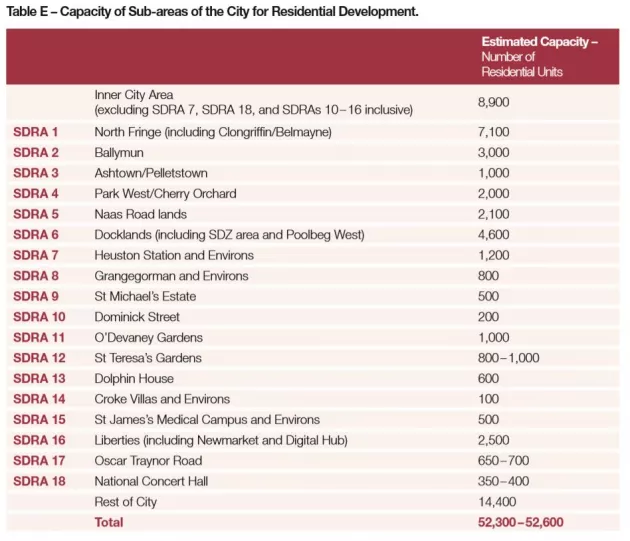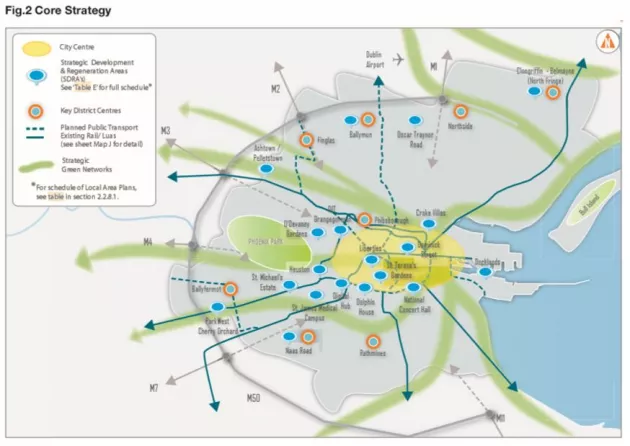2.2.3 Settlement Strategy
2.2.3 Settlement Strategy
Dublin city in its entirety lies within the metropolitan area and the RPGs give direction to Dublin city as the ‘gateway core’ for high-intensity clusters, brownfield development, urban renewal and regeneration. The RPG settlement strategy for the metropolitan area includes a strong policy emphasis on the need to gain maximum benefit from existing assets, such as public transport and social infrastructure, through the continuation of consolidation and increasing densities within the existing built footprint of the city. A further key aspect is that future expansion, whether housing or mixed-uses, occur in tandem with high-quality rail-based public transport and on a phased basis. The development plan incorporates these principles in a settlement hierarchy which prioritises the inner city, key district centres and strategic development and regeneration areas (SDRAs).
The majority of SDRAs relate to a zoning objective which seeks the social, economic, physical development or rejuvenation of an area with residential, employment and mixed-uses (Z14). These SDRAs have substantial development capacity, not only for residential uses, and a series of detailed guiding principles incorporating urban design and green infrastructure guidance have been set out for each SDRA in Chapter 15.
Table E specifies the housing capacity of different parts of the city. This focuses mainly on the potential of the SDRAs whilst also providing figures for the inner city area and remaining areas (‘rest of city’). The figures are derived from housing land availability data which identifies areas of undeveloped land and provides estimates of housing capacity.
The figures demonstrate that there is more than adequate capacity to meet the city’s housing requirements, the available capacity for 52,600 units being well in excess of the 29,500 units required for the plan period (see previous Tables A and D).
For the inner city, the plan seeks to strengthen and consolidate the robust city-centre mixed-use zoning (Z5), with active promotion of the inner city as an attractive place for urban living, working and visiting; the delivery of housing regeneration projects, the emergence of spatial clusters of economic specialisms, public realm improvements and the strengthening of the retail core, all supported by multiple levels of public transport accessibility in the city centre. It is part of this settlement strategy to fully regenerate the Docklands (via the approved SDZ scheme), and the western end of the central city area including Grangegorman, Heuston environs, and the St James’s Hospital campus and environs.
The key district centres (KDCs) represent the top-tier of urban centres outside the city centre, a number of which form part of the larger SDRAs. Each of the 8 KDCs underpins a wider area and acts as a strong spatial hub providing a comprehensive range of commercial and community services to the surrounding populations. All of the designated KDCs closely align to public transport rail corridors, with the exception of two (Finglas and Northside) which perform an important regeneration role for local communities. This development plan will reinforce the KDCs as sustainable anchors for the suburbs. The KDCs are as follows:
Key District Centres (KDCs):
- Clongriffin and Belmayne (North Fringe East and West)
- Northside
- Ballymun
- Finglas
- Ballyfermot
- Naas Road
- Rathmines
- Phibsborough

